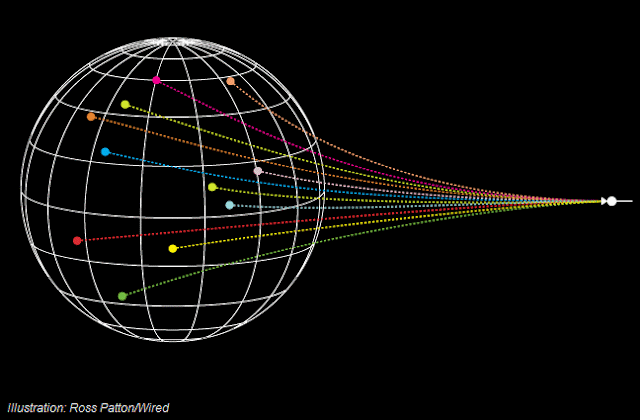My exposure to
the new open, social and participatory world has been eye-opening, thrilling
and disconcerting. This course, ILD 831,
has exposed me to concepts, tools and means of communicating I wasn’t aware of
or only heard about. For example, I was
introduced to Massive Open Online Courses (MOOC) and free online initiatives
such as Saylor.org. I was very aware of
MIT’s open logistics courses, which I found very useful in the past. But had never known of these courses as part
of MOOC.
As an aside
with respect to MOOC, I analyzed the tens of online courses (I have taken) and assessed their
positives and negatives. While the
positives mostly concerned ease of access, the negatives included:
·
No
instructor feedback except for grading
·
No
online collaboration
·
Adequate
to only average online collaboration
·
Multiple
systems to learn
While I had
read Thomas Friedman’s The World is Flat, I gained much insight into what the
book got right and what it might have oversold (see Richard Florida and The
World is Spiky).
I reviewed
SnagIt for the class, finding:
What Snagit does, Snagit does very well.
My favorite use for Snagit is grabbing, copying and pasting graphics of
any source, resolution and shape into PowerPoint presentations. I prepare data driven spreadsheets, charts,
and other graphics from MS Excel, MS Access, MS Word, among other
applications. What I use Snagit for is to
grab a part of any digital document and paste the resulting high-resolution image
directly onto PowerPoint slides, all in 3-5 clicks of a mouse.
We then
analyzed Friedman’s Triple Convergence, the coming together of three
transformations at the same time, from the 1990’s through the mid 2000’s:
·
Friedman’s
ten “flatteners” that he described as enabling the world community to come
together, including flatteners such as uploading, outsourcing, offshoring,
insourcing, in-forming, etc.
·
The way
people interacted and did business, e.g. Friedman’s discussion of Southwest
Airlines’ availing of the check-in process online.
·
The
addition of billions of people in China, India, Russia and elsewhere filling
the vacuum created by the flatteners and new processes
Our next topic
concerned the changing nature of work. What resonated most was Husband’s Wirearchy,
which he described as “a dynamic two-way flow of power and authority, based on
knowledge, trust, credibility and a focus on results, enabled by interconnected
people and technology.” He said that leaders
must be “deeply aware of and mindful about the scope and reach of
interconnected markets and flows of information”, and “be prepared to listen
deeply, be responsible, be accountable and be transparent.” The article was a great read because it
provided reasonable guidelines not only for leaders, but also for managers,
employees, and citizens.
Next, we
looked closely at the opportunities and challenges of networked workers. What was interesting to me was that it still
was primarily cultural bias – not technology constraints – that inhibited
greater embracing of teleworking. John
A. Challenger, chief executive officer of Challenger, Gray & Christmas,
said that companies that have widely adopted telecommuting are realizing
significant savings in many areas but, most notably, real estate costs. This is an obvious benefit. But he warns:
Companies are
embracing the latest portable tablets and laptops, social networking, video
conferencing and many of the other technological advancements that make
telecommuting increasingly viable. However, in many ways, companies are stuck
in the old way of doing business, where people are expected to work from 9 to 5
and are judged more on the amount of ‘face time’ than on the quantity or
quality of output.
I then
researched and wrote on Cybercrimes.
What resonated with me is that even though cybercrimes are now taking
front and center at news rooms across the country, many businesses still think
they are immune to the problem and/or do not realize how much in jeopardy their
digital business assets are (subject to threats such as viruses, worms, Trojan
horses, logic bombs, etc.).
Finally, we
then looked at Kevin Kelly’s keynote at Web Expo 2.0 (on March 29, 2011), Corning's A Day Made of Glass and Google's recent Google’s Glasses announcement. I
wrote a petulant diatribe against this bombardment of new means of passing and
receiving data, but was quickly reminded that many whom experience change at
first are resistant to it. Amen. I am still struck by Kelly’s mention of studies
that concerned how small babies contort to interact with an Ipad. For
example, this from the Wall Street Journal:
"He's concentrating," says Sandra Calvert, a professor at
Georgetown University. It's physiologically the same thing he does while deeply
immersed in, say, Legos. Psychologists call it "flow experience."
There is a subtle difference: The child decides when a building is
finished; an app determines when the task is completed correctly. Researchers
say it's unclear whether this difference has any impact on a child.
My leadership
will change for the better as I get more comfortable with the new always
connected, always transmitting, always receiving world. My innate resistance may have more to do with
my lot in life whereby I still chase the brass ring, but not as quickly or engaged as I used to be and with much greater recovery time!
Reading my
cohort’s blogs was very instructive. I was
amazed each week reading the different viewpoints and insights on the same topic. I look forward to engaging with the cohort
this week as we wrap the eight weeks. Going forward, I
should attack my inhibitions to this new technology and need for constant engagement and data … Excerpted from Dylan Thomas:
Do not go gentle into that good night,
Old age should burn and rave at close of day;
Rage, rage against the dying of the light…









